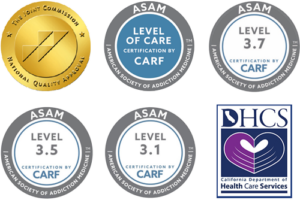How to Ease Alcohol Withdrawal Symptoms
Published on: November 5, 2024 | Updated on: October 28, 2025
Alcohol withdrawal symptoms can be difficult and uncomfortable. Learn how to identify alcohol withdrawal syndrome symptoms and to manage the discomfort with our complete guide.
Has your alcohol consumption begun to take its toll on your physical, mental, and social health? Have you tried to quit drinking alcohol, but were faced with the symptoms of alcohol withdrawal? In our guide to reduce withdrawal symptoms, we’ll explore factors determined by clinical and diagnostic research about alcohol intake, alcohol dependence, and the risk factors associated with the more severe symptoms of alcohol withdrawal.
What is Alcohol Withdrawal?
According to the National Institute on Alcohol Abuse and Alcoholism (NIAAA), alcohol withdrawal is defined as the set of symptoms that occur when a person who has been regularly consuming alcohol heavily reduces or stops their intake. Alcohol is a central nervous system depressant, and over time, the body and brain adjust to its presence. When alcohol consumption is suddenly reduced or discontinued, the body experiences a period of adjustment that can result in both physical and psychological symptoms.
These symptoms occur because long-term alcohol use changes how the brain functions, particularly how it regulates neurotransmitters. Alcohol enhances the effects of a neurotransmitter called gamma-aminobutyric acid (GABA), which slows brain activity, leading to relaxation and a sedative effect. Over time, the brain compensates by reducing its sensitivity to GABA. Alcohol also suppresses the activity of glutamate, a neurotransmitter that increases brain activity. As the body adapts, it becomes accustomed to these adjustments and maintains a new balance. When alcohol is suddenly removed, this balance is disrupted, causing the nervous system to become hyperactive.
Alcohol withdrawal symptoms can range from mild discomfort to severe and life-threatening complications, such as seizures and delirium tremens (DTs). They typically follow a predictable pattern over hours or days after cessation, and medical supervision is often recommended for those experiencing moderate to severe symptoms.
Withdrawal Symptoms from Mild to Severe
Alcohol withdrawal symptoms can vary widely, depending on factors like the duration and intensity of alcohol use, individual health conditions, and whether detox from alcohol misuse is managed with medical supervision.
For those accustomed to regular, heavy alcohol consumption, the body and brain adapt to the presence of alcohol, making abrupt cessation a significant physiological shock. As the body attempts to regain balance without alcohol’s depressive effect on the nervous system, a range of withdrawal symptoms can arise.
These symptoms generally fall into two categories: mild withdrawal symptoms, which are uncomfortable but manageable, and severe symptoms, which can be dangerous or even life-threatening if left untreated. Recognizing the difference between these levels of withdrawal can guide individuals toward appropriate support and interventions during this challenging period.
Mild Symptoms:
These symptoms typically appear within 6 to 12 hours after the last drink:
- Headaches – Persistent and often throbbing.
- Nausea and Vomiting – Digestive upset, often accompanied by a lack of appetite.
- Sweating – Excessive perspiration, even in cool environments.
- Tremors (Shakiness) – Most noticeable in the hands but can affect the whole body.
- Anxiety and Restlessness – Feelings of unease, agitation, or worry.
- Insomnia – Difficulty falling or staying asleep, often due to increased anxiety.
- Increased Heart Rate – Faster than normal heartbeats as the body adjusts to the absence of alcohol.
Severe Withdrawal Symptoms
These symptoms can emerge 24 to 48 hours or later and may require immediate medical attention:
- Seizures – Sudden convulsions, which can be dangerous and may occur without warning.
- Hallucinations – Seeing, hearing, or feeling things that aren’t there, often frightening in nature.
- Delirium Tremens (DTs) – A severe and potentially fatal condition involving extreme confusion, high fever, sweating, rapid heart rate, and agitation.
- Severe Disorientation and Confusion – Difficulty with cognitive processing, often feeling lost or unsure of surroundings.
- Hypertension – Elevated blood pressure, which can increase the risk of other complications.
- Mood Disturbances – Extreme irritability, mood swings, and even aggression.
Note on Severity
The severity and presence of symptoms vary depending on factors like the length and intensity of alcohol use, overall health, and whether the withdrawal is supervised. Under an inpatient alcohol detox treatment setting, those struggling with moderate alcohol withdrawal or more severe withdrawal issues like seizures, delirium tremens, or physical health complications, these symptoms can be managed effectively. Even outpatient treatment regimens can help to reduce the more unpleasant side effects of alcohol withdrawal.
Alcohol Withdrawal Syndrome: What is it and How is it Treated?
Alcohol Withdrawal Syndrome (AWS) is a set of symptoms that occur when a person who has been drinking heavily and regularly suddenly stops or significantly reduces their alcohol intake. This syndrome results from the body’s physical dependence on alcohol, developed over time through prolonged use. When alcohol is abruptly removed, the central nervous system, which has adapted to the presence of alcohol, becomes hyperactive, leading to a variety of physical and psychological symptoms.
Treatment of Alcohol Withdrawal Syndrome
For individuals experiencing AWS, treatment depends on the severity of symptoms:
- Mild to Moderate Cases: May be managed in an outpatient setting with hydration, rest, supportive care, and medications to reduce symptoms.
- Severe Cases: Typically require inpatient treatment in a hospital or detox facility, where medications (like benzodiazepines) and fluids can be administered under medical supervision to prevent complications like seizures or DTs.
Alcohol Withdrawal Syndrome is potentially serious, especially for heavy or long-term drinkers. Those who anticipate experiencing withdrawal symptoms are often advised to seek medical support to manage the process safely.
How Can I Manage Withdrawal Symptoms?
Managing alcohol withdrawal symptoms can be done in various settings—outpatient, at-home, or inpatient—each providing unique benefits depending on the severity of symptoms and individual health needs. Here’s an overview of strategies tailored for each setting:
1. Outpatient Setting
Outpatient care is suitable for individuals with mild to moderate withdrawal symptoms who do not require 24-hour supervision. This option allows them to maintain some daily routines with regular medical oversight. Common strategies include:
- Medical Assessment and Monitoring: Regular check-ins with healthcare professionals to monitor vital signs, symptoms, and any need for escalation to inpatient care.
- Medication Assistance: Prescriptions such as benzodiazepines or anti-seizure medications are often used to manage symptoms like anxiety, tremors, and prevent seizures. These are usually provided in small doses with guidance to avoid misuse.
- Behavioral Support: Outpatient programs often provide access to counseling, support groups, and cognitive-behavioral therapy to address underlying issues related to alcohol use.
- Hydration and Nutrition: Medical teams emphasize hydration and a nutrient-rich diet to support physical recovery and address deficiencies that can exacerbate symptoms.
2. At-Home (Self-Managed with Guidance)
This option may be suitable for those with mild symptoms who have a strong support network and can safely detox without constant medical supervision. However, it’s generally recommended to do this with some level of professional guidance. Alcohol detox may result in unexpected symptoms or complications, necessitating the need for medical professional assistance.
- Access to Telehealth: Many providers offer telehealth check-ins, allowing individuals to consult healthcare professionals remotely if symptoms intensify.
- Hydration and Diet: Alcohol withdrawal can cause dehydration and nutrient deficiencies, so staying hydrated with water, electrolyte solutions, and eating balanced meals can help alleviate some symptoms.
- Over-the-Counter Supplements: Vitamins like thiamine (B1), magnesium, and folic acid are often recommended to replenish deficiencies common in those with alcohol use disorder.
- Structured Routine and Rest: A consistent daily routine that includes rest, light physical activity, and relaxation techniques, such as deep breathing or meditation, can help manage anxiety and promote better sleep.
3. Inpatient Setting
Inpatient or residential treatment is recommended for individuals with severe symptoms or those at high risk of complications, such as seizures or delirium tremens (DTs). This is a fully supervised environment with 24/7 medical and psychological support.
- Medical Detoxification: In an inpatient setting, medications like benzodiazepines are administered and carefully monitored to prevent severe withdrawal symptoms and complications.
- Close Monitoring of Vital Signs: Medical professionals continuously monitor blood pressure, heart rate, temperature, and other vital signs to quickly respond to any changes that indicate worsening symptoms.
- Symptom-Specific Medications: In addition to benzodiazepines, other medications may be used to manage specific symptoms, such as antipsychotics for hallucinations or beta-blockers to reduce heart rate and anxiety.
- Comprehensive Support Services: Inpatient care often includes psychological support, addiction counseling, and therapy sessions to address the emotional and psychological aspects of withdrawal.
- Nutritional Support and IV Fluids: Many facilities provide intravenous fluids and balanced nutrition to address severe dehydration or nutritional deficits, promoting quicker recovery.
Selecting the Right Setting
The choice of setting should be based on a professional assessment of the individual’s health, the severity of the symptoms of withdrawal, and personal support networks. While mild cases of alcohol detox may be managed at home or with outpatient care, more severe cases necessitate the safety of an inpatient environment to ensure proper treatment and a safer withdrawal process.
Long Term Effects of Heavy Drinking
Heavy drinking has a range of long-term effects that impact not only physical health but also mental well-being and social relationships. Here’s a breakdown:
1. Physical Effects
- Liver Damage: Long-term alcohol use can lead to liver diseases such as fatty liver, alcoholic hepatitis, cirrhosis, and an increased risk of liver cancer.
- Cardiovascular Problems: Heavy drinking raises blood pressure, increases cholesterol levels, and can lead to heart disease, irregular heartbeat (arrhythmias), and even heart failure.
- Digestive System Issues: Alcohol can damage the stomach lining, leading to gastritis, ulcers, pancreatitis, and increased risk of gastrointestinal cancers.
- Weakened Immune System: Chronic alcohol use weakens the immune system, making the body more susceptible to infections and illnesses.
- Neurological Damage: Long-term alcohol abuse can lead to brain damage, including conditions like Wernicke-Korsakoff syndrome (a severe memory disorder) due to vitamin deficiencies, especially thiamine (B1).
- Bone and Muscle Health: Alcohol can deplete calcium and other essential nutrients, leading to brittle bones (osteoporosis) and muscle weakness.
2. Mental Effects
- Cognitive Impairment: Long-term alcohol use affects memory, learning, decision-making, and can contribute to dementia or alcohol-related brain damage.
- Mood Disorders: Chronic drinking is linked to a higher risk of depression, anxiety disorders, and mood instability, which can worsen with time.
- Sleep Disturbances: Alcohol disrupts the sleep cycle, causing chronic insomnia and poorer quality of sleep, which affects mental health and cognitive function.
- Increased Risk of Addiction: Long-term heavy drinking creates a physical and psychological dependence on alcohol, making it harder to quit and increasing the risk of relapse.
- Risk of Psychosis: In severe cases, heavy drinking can lead to psychotic symptoms, such as hallucinations and paranoia, particularly during withdrawal.
3. Social Effects
- Relationship Strain: Alcohol abuse can lead to conflicts with family, friends, and romantic partners, often resulting in trust issues, emotional distance, or even separation and divorce.
- Workplace Challenges: Heavy drinking can affect job performance, leading to absenteeism, decreased productivity, conflicts with colleagues, and, in severe cases, job loss.
- Legal and Financial Issues: Many who struggle with alcohol use face legal problems, such as DUI arrests or other alcohol-related offenses, and financial strain due to the cost of alcohol or related healthcare expenses.
- Social Isolation: Long-term alcohol use can contribute to isolation as relationships break down, social circles shrink, and self-esteem issues increase, which can perpetuate the cycle of addiction.
- Impact on Children and Family Dynamics: Family members, particularly children, are often affected by a loved one’s alcohol use, leading to issues such as anxiety, depression, and intergenerational patterns of substance abuse.
Understanding these long-term effects underscores the importance of early intervention and treatment to mitigate the damaging consequences of heavy drinking on all aspects of life.
A Guide to Alcohol Abuse Signs: Are You Ready to Take Your Last Drink?
Recognizing the signs of alcohol abuse is an important first step toward understanding if you may have a drinking problem. Alcohol abuse affects individuals differently, but there are several common signs that can help identify a problematic relationship with alcohol. Here’s an overview of signs to consider:
1. Physical Signs
- Increased Tolerance: Needing to drink more alcohol to achieve the same effect or to “feel normal.”
- Withdrawal Symptoms: Experiencing symptoms such as shaking, sweating, nausea, anxiety, or irritability when not drinking.
- Frequent Hangovers: Regularly experiencing hangovers that affect your ability to function during the day.
- Neglecting Health: Ignoring self-care, exercise, or nutrition due to drinking.
2. Behavioral Signs
- Drinking More than Intended: Consistently drinking more alcohol or for a longer period than originally planned.
- Failed Attempts to Cut Down: Trying to reduce alcohol intake but finding it difficult to stick to these limits.
- Spending Excessive Time Drinking or Recovering from Drinking: Allocating significant time to drinking, recovering from hangovers, or dealing with alcohol’s effects.
- Neglecting Responsibilities: Failing to fulfill work, school, or family obligations due to drinking or its aftereffects.
- Risky Situations: Drinking in dangerous situations, like while driving, swimming, or operating machinery.
3. Psychological Signs
- Craving Alcohol: Experiencing a strong, persistent urge or compulsion to drink.
- Drinking to Cope: Relying on alcohol to relieve stress, anxiety, depression, or other emotional difficulties.
- Mood Changes: Noticing mood swings, irritability, or depression related to drinking.
- Denial or Minimization: Downplaying or denying the extent of alcohol use to yourself or others.
- Loss of Control: Feeling as though alcohol use is out of your control, even if you want to stop or reduce consumption.
4. Social Signs
- Avoiding Social Activities: Declining invitations or missing events if they don’t involve drinking or if alcohol won’t be available.
- Relationship Strain: Experiencing frequent conflicts with family, friends, or partners about your drinking.
- Isolation: Drinking alone more often or preferring to drink in isolation rather than with others.
- Legal or Financial Trouble: Facing legal issues like DUI charges or financial problems due to spending on alcohol or related behaviors.
Self-Assessment: Do You Have a Drinking Problem?
If you’re wondering if you may have a drinking problem, consider asking yourself the following questions:
- Have you tried to cut down on your drinking but struggled to do so?
- Do you feel guilty or ashamed about your drinking?
- Has anyone close to you expressed concern about your drinking habits?
- Do you need a drink to start your day or to feel “normal”?
- Do you find yourself thinking about or craving alcohol frequently?
Answering “yes” to one or more of these questions may indicate that alcohol is playing a problematic role in your life. Consulting a healthcare provider, therapist, or addiction counselor can provide further guidance and help you assess your relationship with alcohol. Early intervention is often key to reducing the negative effects of alcohol abuse and regaining control.
Commit to Treatment. Keep Your Job!

Contact Journey Hillside Tarzana Today
Alcohol addiction is a severe and potentially ruinous condition that can leave harrowing scars and damage upon an individual’s life. However, it’s valuable to remember that recovery is possible and it is necessary to get the right help and support so you can live your life to the fullest. Seeking medical treatment for heavy drinking is a testament to strength, not a sign of weakness, and it’s the first step towards reclaiming control over one’s life.
If you are beset with the torture of heavy drinking and alcohol use disorder symptoms, don’t hesitate to reach out to Journey Hillside. We absolutely know and applaud you for the courage it takes to seek help and we’re ready to embrace you and give you the highest level of care and support you deserve. Our team of mental health professionals stands ready to help you identify the warning signs of alcoholism, help limit alcohol cravings during the sobriety journey, and provide support for mental health and physical health complications. Call today to speak to our Admissions Team.





